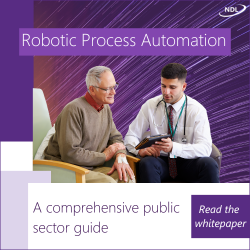
GeoPlace is collaborating with the Valuation Office Agency to improve data flows for local taxation, writes Steve Brandwood, executive director of engagement
The Valuation Office Agency (VOA) has major responsibilities and significant challenges in its role in valuing properties for council tax and non-domestic rates in England and Wales.
It has to manage an address for every hereditament – which identifies a property liable for local taxation rates – provide valuations, maintain accurate lists of council tax and business rates and share the data with local billing authorities.
The process for establishing a ratable property involves local authorities providing information on new properties to the VOA and it returning a valuation to enable them to send bills for council tax and non-domestic rates to the property.
In parallel, GeoPlace collects address data from local authorities to maintain the National Address Gazetteer (which is distributed to users by Ordnance Survey as the AddressBase Products and as part of their new National Geospatial Database offering).
In order to validate and check for accuracy and completeness of local authority address updates, GeoPlace is provided with a weekly file of addresses from the VOA which it matches against local authority address data. Unique property reference numbers (URPNs) are added to the VOA data and returned to the organisation. This places VOA in an important position in the address ecosystem that supports public services in the UK.
But there are difficulties in the process, with interoperability and operational issues caused by inconsistent data structures, time lags, variations in how the local billing authorities and VOA describe and manage their data, and legacy IT issues.
Ambition for improvement
The VOA has ambitions for significant improvements. Part of this is a long term plan for business systems transformation that includes a new case management system, a valuation rules engine, data models and storage capability, all underpinned by a flexibly structured model for the creation and maintenance of property data. The quality of the data will be maintained through architecture guardrails, consistent standards and validation.
The agency has also been working with GeoPlace – which manages UPRNs nationally and oversees the production and maintenance of national address and street gazetteers – on understanding the issues and how workflows and data exchange could be better optimised. This involves a strategic shift away from address creation by the VOA to consuming authoritative addresses, along with their UPRNs, that come from local authority maintained local land and property gazetteers (LLPGs).
Ensuring that the UPRN for an address flows through the system end-to-end is vital to ensuring that the VOA and local authorities are aligned on property information. Although local authorities are now routinely attaching UPRNs to addresses on the LLPGs, and these generally flow through to council tax and non-domestic rates systems, this is not always the case.
The VOA's legacy systems have not accommodated UPRNs to date; so when the VOA creates a hereditament the UPRN is not currently included and has to be reattached by GeoPlace at the end of the process. This results in a number of records that cannot be given UPRNs automatically and have to be reviewed by local authorities to get close to a 100% match between VOA and local authority address data.
Plan for UPRNs
The VOA has recognised this as a problem and wants to include the UPRN across its IT estate and as part of a standardised way of publishing data - the latter meeting government policy and marketing requirements for property data.
Local authority planning and building control processes underpin the creation of new property addresses. In order to establish timely address change data with UPRNs attached, it is vital that these process are streamlined through LLPGs to ensure the UPRN and standardised descriptions are captured at consistent and appropriate points in the development process.
The level of integration of these systems has grown hugely over the last decade, but it is not consistent across all local authorities. Making this consistent would ensure the UPRN is attached at three key trigger points - when a planning application is approved, the commencement of construction, and building completion.
In turn, this would drive improvements within local authorities (knowing when new properties come online is important for planning and delivering services) and provide a consistent feed of new address information to the VOA in a structured away.
Researching the problem
GeoPlace initiated a research project, with VOA support and beginning in October 2022, to review the current processes and data models in a small group of local authorities.
It confirmed some of the problems outlined above. These include the complex ecosystem for address data that involves a number of partners, and the complexity of describing business properties where a single UPRN cannot always be matched accurately with a hereditament.
The research has also identified scope for improvements and produced a series of recommendations. These include: improving guidance to the VOA and local authorities; the adoption of standards such as using the UPRN end to end; reviewing the data model of exchange between local authorities and the VOA to manage complex sites; and providing detailed guidance and support to local authorities on the integration of early property lifecycle triggers into LLPGs.
In addition, the research showed a mixed picture of councils’ awareness of the scope for sharing data. Some were unaware of the VOA’s Information Sharing Gateway and thought the agency was not willing to share plans or other information to validate addresses. But all the respondents reported a good working relationship with their billing authority colleagues, which can facilitate access to key data extracts and reports and is essential to make the process work.
Interoperability issue
The report also identifies differing levels of interoperability between billing authority systems and the LLPG, which makes the processes for council tax and business rates challenging. But all the councils demonstrated a good working knowledge of what VOA is trying to achieve and see interactions with it as a key source of property intelligence.
It led to a perception that it is crucial that the LLPG is complete and up-to-date with UPRNs attached. Billing authorities can subsequently use it as a single source of truth for address creation and mapping, and this can lay the ground for improving the interoperability of their systems with those of VOA.
The organisations are about to begin a second phase of work that will focus on the details of process mapping, data standards and a cost-benefit analysis to support a national roll out of the approach. This will involve a number of local authorities taking part in pilot projects to identify where further improvements could be made.
GeoPlace will continue to work closely with the VOA and other stakeholders in the programme, which demonstrates the value of working collaboratively to identify and overcome the problems in data flows that affect VOA’s operations. It also promises to spur improvements in local government’s use of data, providing further momentum to the standardisation of data that underpins efficiency and transformation.
Heather Whicker, director of information data and analysis at the VOA spoke at the recent GeoPlace annual conference. You can see her presentation on the Thursday 11th May 2023 tab, which also includes a write-up of the session.





